This is the second part of the Seattle trip, covering the second half of Thursday, as well as Saturday.
As we left Friday Harbor to begin the whale-watching tour, we entered much choppier water, and since the nearest report of Orcas was quite a distance away, we had to go quickly in order to stay on schedule. As a result, some people got seasick. There was complementary meclizine, though, for those who wanted it. Fortunately, I don't get seasick, so I felt fine. Below is a photo of the choppier water.
As mentioned in the previous post, there were a lot of Rhinoceros Auklets. Until about halfway through the whale-watching tour, there were many flocks of auklets, as well as some guillemots, murres, and gulls. Below are five photos of Rhinoceros Auklets. In the first photo, the two whitish birds at the right are Common Murres.
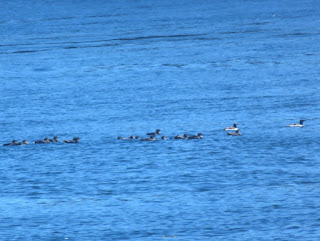 |
| Rhinoceros Auklets and Common Murres |
 |
| Rhinoceros Auklet |
 |
| Rhinoceros Auklets |
 |
| Rhinoceros Auklet |
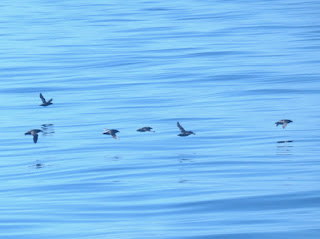 |
| Rhinoceros Auklets |
Where the Orcas had been sighted, there were a few whale-watching boats floating around. We sat and waited, then after a minute or so, a group of Orcas came to the surface. At first, a male Orca (tall, straight dorsal fin) was the main focus of attention. Then, a small group that included a female (shorter, curved dorsal fin) and her baby came and swam fairly close by. The Orcas were very impressive, and everyone on the boat was able to get very good views of them. However, since we still had to stay on schedule, we had to leave the Orcas after a while. Below are five photos. The first is of the male Orca. The rest of the photos are of the small group with the mother and baby (in all of them, the mother is in front with the tallest dorsal fin - she was identified by a small chip out of the middle of her fin - and the baby is the small one in the middle with the shortest dorsal fin).
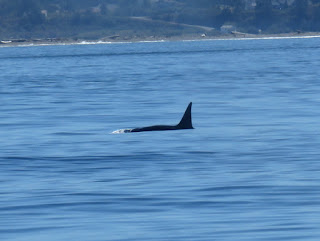 |
| Orca |
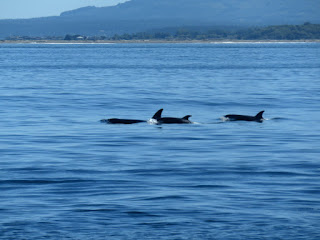 |
| Orcas |
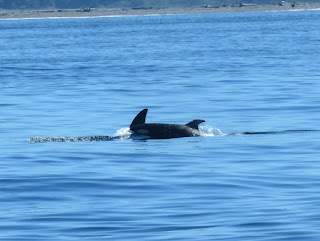 |
| Orcas |
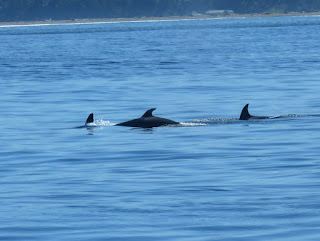 |
| Orcas |
 |
| Orcas |
As we returned to Friday Harbor, I saw another Bald Eagle soaring around above the trees. Below is a photo of it.
 |
| Bald Eagle |
After spending about an hour and a half in Friday Harbor, everyone got back on the boat to head back to Seattle. On the way there, we paused at a small island where a male Steller Sea Lion was sitting. He was very large (Steller Sea Lions are the largest of the eared seals) and had a dog-like face. He watched us go by the island, but stayed where he was. Below is a photo of the Steller Sea Lion.
 |
| Steller Sea Lion |
There were other wildlife on the island, too, besides the sea lion. As I was looking at the island, I saw small dark shapes moving over it. I couldn't see them very well, so I took photos, hoping I'd catch one. I did, and discovered they were Black Oystercatchers. Black Oystercatchers are found year-round along the Pacific Coast from the Aleutian Islands down to Baja California. They are distinctive with their entirely black plumage, bright red bills, and pale legs and feet. True to their name, they catch oysters and other mollusks. There were quite a few of them running around on the island, though they blended in pretty well with the dark rocks. Below is a photo of one of them (the thing in the lower right corner is the sea lion's head).
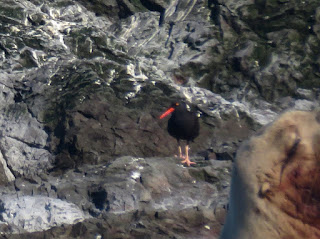 |
| Black Oystercatcher and Steller Sea Lion |
There were also numerous cormorants on the island. There were Double-crested, Brandt's, and Pelagic Cormorants there, just sitting around. In the photos below, there are only Brandt's and Pelagic. Pelagic Cormorants are found in northern Alaska in the summer and northern Baja California in the winter. Along the coast from the Aleutian Islands down to California, they are around all year. They are smaller than Brandt's and Double-crested Cormorants and are entirely dark-colored except for white patches on their flanks during breeding season. They have slender necks, thin bills, and long tails. As their name suggests, they are found on the open ocean. Below are two photos. They are the same photo, but the second is zoomed in to better show a Pelagic Cormorant, which is the smaller one in the back right. In the first photo, besides the cormorants, there is a Black Oystercatcher and a Heermann's Gull in the middle at the bottom.
 |
Brandt's Cormorants, Pelagic Cormorants, Heermann's Gull,
and Black Oystercatcher |
 |
| Brandt's Cormorants and Pelagic Cormorant |
On the other side of the island, there was a large group of Harbor Seals sleeping and basking in the sun. A few were swimming in the water nearby. Below are two photos of them.
 |
| Harbor Seals |
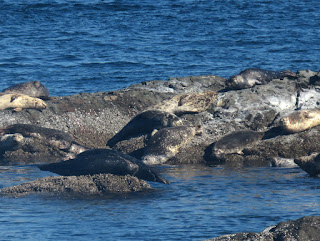 |
| Harbor Seals |
On the way back to Seattle, we saw a small group of Minke Whales, which are the smallest baleen whales in North American waters. They came very close, but unfortunately, I wasn't able to get a photo. We also saw more seabirds and Harbor Seals, but my camera was almost out of battery, so I couldn't take any more pictures. I did take a couple photos of the landscape as we returned to Seattle. Below are the photos.
On Saturday, we went to the Seattle Aquarium, which was a very nice aquarium. Besides the fish and invertebrates, they also had marine mammals (Harbor Seals, Northern Fur Seals, Sea Otters, and River Otters), as well as an exhibit with alcids and shorebirds that are found in the area. I didn't take any photos of the fish, invertebrates, or mammals (it was way too dark), but I took a few photos of the birds. Below are a Black-bellied Plover, Common Murres, and Tufted Puffins (in that order).
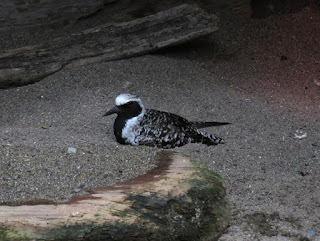 |
| Black-bellied Plover |
 |
| Common Murres |
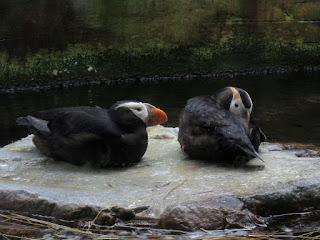 |
| Tufted Puffins |
The mammal and bird exhibits were open air exhibits and had a great view of Elliot Bay. We climbed some stairs to a platform that overlooked the top of the Tufted Puffin exhibit. In the shade of the trees were three sleeping gull chicks. Their mother was a little way off and began calling to them with a very soft sound. They woke up and ran over to her, then started wandering around and flapping their fuzzy wings. They were very cute. Since I didn't have my field guide with me, I had to look them up later, and it turns out they were Glaucous-winged Gulls, which I'd never seen before. Glaucous-winged Gulls are found in northern Alaska in the summer and along the Pacific Coast from Oregon to the tip of Baja California in the winter. They are found all year from just above the Aleutian Islands down to Washington. Glaucous-winged Gulls are large, pale gulls with dark eyes, pink legs, and gray wingtips. In the winter, they have speckled brown heads. Below are five photos. The first is of two of the chicks sleeping and the second is of the mother with the three chicks. The third and fourth are of the chicks by themselves, and the fifth is of the mother.
 |
| Glaucous-winged Gulls |
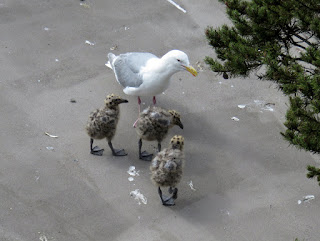 |
| Glaucous-winged Gulls |
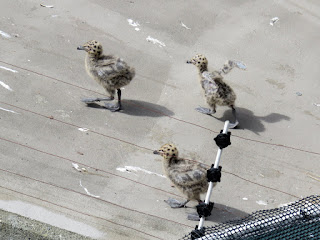 |
| Glaucous-winged Gulls |
 |
| Glaucous-winged Gulls |
 |
| Glaucous-winged Gull |
After visiting the aquarium, we stood on the pier next to it and looked out over the bay. Below is a photo of the Seattle Great Wheel and Elliot Bay.
On the water near the pier were a couple of Pigeon Guillemots. One was very close to us (almost right below). It was preening itself, then vigorously flapping its wings. It was very small (pigeon-sized) and in nice breeding plumage, and I was able to take a few good photos of it. Below are three photos of the guillemot.
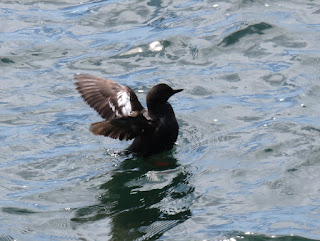 |
| Pigeon Guillemot |
 |
| Pigeon Guillemot |
 |
| Pigeon Guillemot |
No comments:
Post a Comment